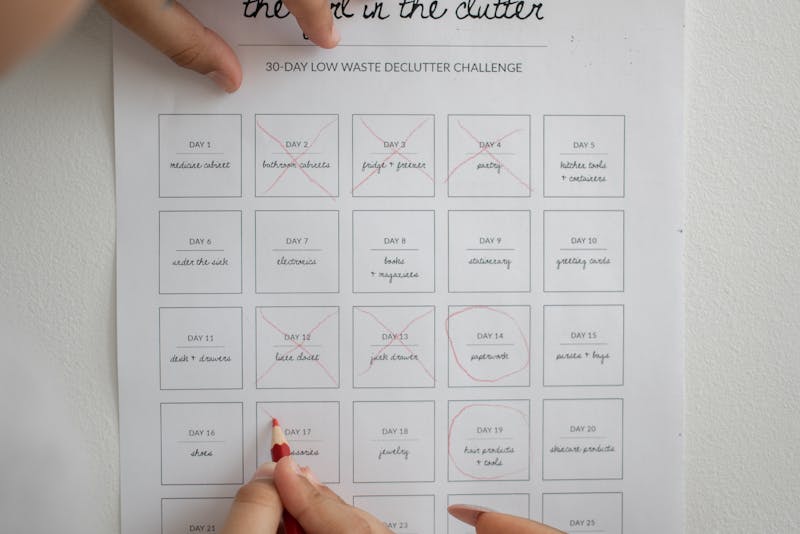- Weekly chores maintain daily cleanliness, prevent dirt buildup, and keep your home comfortable.
- Monthly chores focus on deep cleaning, maintenance, and areas that don’t need constant attention.
- Assign tasks based on frequency needs, household size, lifestyle, and specific health or allergy concerns.
- A printable house cleaning checklist simplifies routines, helps track progress, and reduces stress.
- Customizing your checklist ensures it fits your home, schedule, and unique cleaning priorities.
- Consistent routines prevent overwhelm and make long-term home maintenance more manageable.
- Delegating chores and breaking tasks into steps increases efficiency and keeps the whole household involved.
Keeping a home clean can feel overwhelming—especially when chores start piling up faster than you can address them. For many homeowners, the real challenge isn’t the cleaning itself but figuring out how often certain tasks should be completed. Some chores need attention every few days, while others can be handled once a month without affecting your home’s comfort or hygiene.
This article breaks down the difference between weekly and monthly chores, explains how to prioritize tasks, and offers a structured approach you can follow. By the end, you’ll have a clear and practical system, plus guidance on how to use a printable house cleaning checklist to stay organized year-round.
Understanding the Difference Between Weekly and Monthly Chores
Before you can build a cleaning routine that works for your lifestyle, it’s important to understand what separates weekly chores from monthly responsibilities. Weekly chores typically focus on maintaining the day-to-day cleanliness of your home. These tasks help keep surfaces sanitary, reduce clutter, and prevent dirt and grime from accumulating.
Monthly chores, on the other hand, involve more thorough cleaning. They address the areas that don’t need daily or weekly attention but still require consistent upkeep to avoid long-term damage and preserve the condition of your home. When you know what belongs in each category, it becomes much easier to structure your schedule, avoid cleaning burnout, and keep your home consistently tidy.
Why the Timing Matters
Assigning the right frequency to each chore ensures your cleaning routine is both effective and manageable. If you try to handle everything every week, you’ll feel exhausted. If you stretch chores too far apart, your home will quickly become dusty, cluttered, and harder to maintain. A well-defined schedule helps strike a balance and prevents chores from becoming larger, time-consuming projects.
How Weekly Chores Keep Your Home Fresh and Comfortable

Weekly chores are the backbone of any successful cleaning routine. These tasks are essential to keeping your home presentable, healthy, and comfortable for everyday living. Completing them regularly prevents dirt from building up and reduces the amount of deep cleaning you need to do later. They also help maintain a routine that feels predictable and easy to follow. Most homeowners can complete weekly chores in short sessions, making them ideal for busy schedules.
Common Weekly Chores to Include in Your Routine
Here are the most common weekly cleaning tasks that help keep your home running smoothly:
- Vacuuming floors, carpets, and area rugs
- Sweeping and mopping hard floors
- Wiping kitchen counters and appliances
- Cleaning bathrooms, including toilets, sinks, and mirrors
- Changing bed linens and pillowcases
- Dusting open surfaces
- Taking out household trash
- Wiping down high-touch surfaces such as doorknobs and light switches
How Weekly Tasks Prevent Bigger Problems
Weekly chores may seem simple, but they play a major role in maintaining your home long-term. For example:
- Regular vacuuming keeps allergens from building up
- Weekly bathroom cleaning prevents mold growth
- Wiping kitchen surfaces eliminates germs and reduces pest risks
- Changing linens improves sleep quality and reduces dust mites
A weekly routine acts as a preventive measure and supports the overall health of your home and family.
Why Monthly Chores Are Just as Important as Weekly Tasks
Monthly chores tend to feel less urgent, but they are equally essential. These tasks help deep clean, refresh, and maintain the hidden areas of your home that don’t get as much attention. Without monthly chores, dust, grime, and bacteria can build up in places you don’t see daily. Monthly cleaning also extends the life of furniture, appliances, and home systems.
For busy homeowners, dividing your cleaning between weekly and monthly cycles can significantly reduce stress and keep your home in better condition over time.
Examples of Monthly Chores That Make a Big Difference
While your weekly chores handle everyday maintenance, monthly chores target deeper cleaning tasks such as:
- Cleaning baseboards, trim, and door frames
- Washing windows and glass doors
- Deep cleaning kitchen appliances, such as the refrigerator or oven
- Removing dust from ceiling fans
- Vacuuming upholstery and under furniture
- Washing shower curtains or liners
- Replacing or cleaning HVAC filters
- Decluttering a specific area, such as a closet, pantry, or garage shelf
How Monthly Chores Support a Healthier Home
Monthly tasks help reduce allergens, prevent odors, and keep your home functioning efficiently. They also help catch problems early, such as leaks, mold, or pest issues. Regularly deep-cleaning specific areas improves indoor air quality, keeps your home more organized, and prevents costly repairs caused by neglect.
How to Choose Which Chores Go Weekly and Which Go Monthly
Organizing your cleaning routine begins with understanding your living environment and lifestyle. Not every household has the same cleaning needs. A family with pets or children may need to complete certain tasks more often than a household of two adults. The size of your home, the amount of foot traffic, and even your flooring materials can influence how frequently tasks need to be done.
Factors to Consider When Dividing Chores
To create a cleaning schedule that actually works, consider the following:
- The size of your home
- Whether you have pets
- Whether you have children
- The number of people living in the home
- How much time you spend at home
- Allergy concerns or special health needs
- Materials and finishes that require special care
By understanding your household’s priorities, you can assign each task the right frequency without feeling overwhelmed.
Signs a Chore Should Be Weekly
A chore belongs in the weekly category if:
- Dirt accumulates quickly
- The task affects hygiene or health
- The area is heavily used
- Leaving it uncleaned creates unpleasant odors
- It impacts your home’s comfort or appearance
Signs a Chore Can Be Monthly
A chore is best suited for monthly cleaning if:
- Dirt buildup is slow and manageable
- The task takes longer or requires deeper cleaning
- The area is rarely used
- The chore doesn’t affect your daily comfort or health
The Benefits of Using a Printable House Cleaning Checklist
A printable checklist is one of the simplest and most effective tools to help you stick to a consistent cleaning routine. It eliminates the guesswork, keeps you accountable, and helps you visually track your progress. Many homeowners find that a checklist reduces stress because it breaks the work into manageable steps. Instead of wondering what needs to be done each week or month, the checklist gives you a clear plan to follow.
How a Printable Checklist Supports Routine Building
A printable checklist can help you:
- Create structure
- Stay organized
- Reduce mental overload
- Assign responsibilities to family members
- Track progress over time
- Prevent tasks from being forgotten
Because it’s visible and easy to reference, a checklist makes it easier to stay on schedule, even when life gets busy.
Weekly vs Monthly Chores: Printable House Cleaning Checklist You Can Follow
Below is an easy-to-use checklist that breaks chores into two simple categories. You can print, customize, or laminate it to use weekly or monthly.
House Cleaning Checklist: Weekly Tasks
Kitchen
- Wipe countertops and backsplash
- Clean the sink and faucet
- Empty trash and recycling
- Clean the stove top
- Sweep and mop floors
- Wipe small appliances
Bathrooms
- Clean toilet
- Wipe mirrors
- Clean the sink and faucet
- Scrub shower or tub
- Replace towels
- Empty trash
Bedrooms
- Change bed sheets
- Dust nightstands and dressers
- Vacuum floors or mop
- Put away laundry
- Organize cluttered corners
Living Areas
- Dust shelves and surfaces
- Vacuum carpets and rugs
- Fluff pillows and arrange décor
- Wipe remotes and high-touch surfaces
- Clean glass surfaces
House Cleaning Checklist: Monthly Tasks
Kitchen
- Clean oven and microwave interior
- Empty and wipe refrigerator shelves
- Clean under appliances
- Wash garbage bins
- Check the pantry and declutter items
Bathrooms
- Wash shower curtains and liners
- Clean inside cabinets and drawers
- Scrub tile grout
- Replace or clean ventilation covers
Bedrooms
- Vacuum under furniture
- Deep clean mattresses
- Wash pillows and comforters
- Organize closets
Living Areas
- Dust ceiling fans
- Wipe baseboards
- Wash windows
- Clean behind furniture
- Deep clean upholstery
Tips for Making Your Cleaning Routine More Manageable
Building a cleaning schedule is one thing; sticking to it is another. To keep your home consistently clean without feeling overwhelmed, it helps to simplify the process as much as possible. Start small, build momentum, and adjust the routine as needed. Your cleaning system should fit your lifestyle, not the other way around.
Simple Ways to Stay Consistent
- Set dedicated cleaning days
- Use timers to avoid burnout
- Break large tasks into small steps
- Delegate chores to family members
- Keep cleaning supplies in multiple rooms
- Reward yourself after completing chores
How to Customize Your Cleaning Checklist for Your Home

Every home has unique needs, so it’s important to personalize your printable checklist. Whether you live in a small apartment or a large multi-story home, your cleaning schedule should be realistic. Tailor your checklist based on your habits, preferences, and the areas of your home that require the most attention.
Ways to Personalize Your Checklist
- Add or remove tasks
- Assign chores to specific days
- Color-code weekly and monthly categories
- Make special sections for seasonal chores
- Adjust cleaning frequency during busy seasons
Conclusion
Maintaining a clean and organized home doesn’t have to be overwhelming. By understanding the difference between weekly and monthly chores, using a printable house cleaning checklist, and customizing it to fit your household’s needs, you can create a routine that is both manageable and effective. Consistency, planning, and delegation are key to keeping your home comfortable, hygienic, and well-maintained—without feeling stressed or overworked. With the right system in place, a clean home becomes achievable for every homeowner, week after week, month after month.





